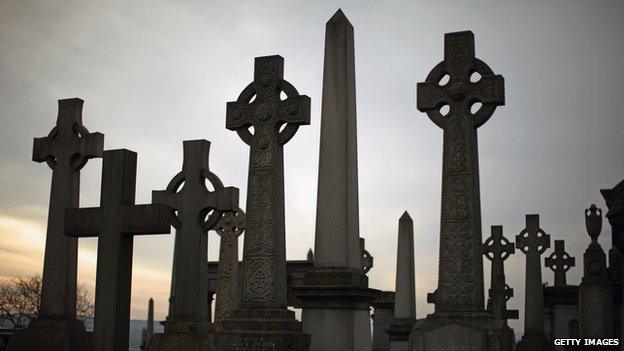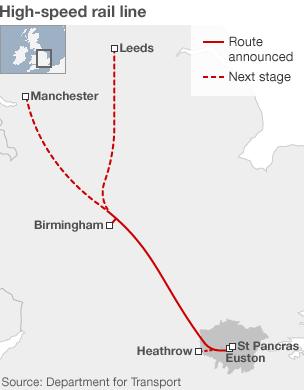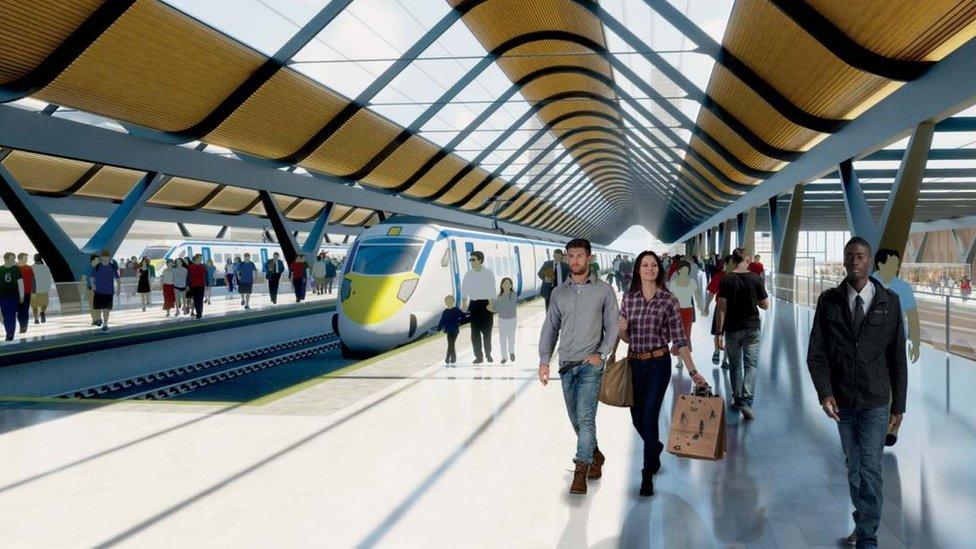Digging up the dead
- Published

Thousands of graves will be dug up and moved to make way for the new high-speed rail line between London and Birmingham. But how does this happen and why do people feel squeamish about it?
The space above ground can belie the congestion below. With each new building and every spade in the ground, something is unearthed.
But in a world where space is short and land is at a premium, what should be left in the soil?
The HS2 rail line is expected to run straight through old cemeteries in London and Birmingham. It is estimated that the remains of about 50,000 people could be affected.
And it is not the only instance.
In Salford, campaigners are fighting the development of an Asda store on an old cemetery believed to have more than 300 graves.
In the US, the Chicago Department of Aviation is just coming to the end of its project to remove about 1,500 graves and use the land for a new runway at O'Hare International Airport, external.
And Walmart has been criticised, external for applying to build on land in Alabama that is believed to be an unmarked graveyard for slaves.
There have always been developments that have touched formerly consecrated ground. In the 1860s when the Henry Barlow rail line to St Pancras was built, novelist Thomas Hardy, at the time a young architecture student, was among the people who took part in a dig to remove old graves.
He wrote about it in his poem The Levelled Churchyard, external in 1882:
"O passenger, pray list and catch Our sighs and piteous groans, Half stifled in this jumbled patch Of wrenched memorial stones!"
Natasha Powers, head of osteology at the Museum of London Archaeology, says there is not much land left in cities that hasn't been used before.
"Coming across human remains is a fairly common thing."
It is Powers's job to study the human remains that have been exhumed for building projects, examining the bones for information about health, disease and demographics from the time they were buried.
Among the projects that she worked on was the Spitalfields development in East London, once a medieval priory, now a trendy shopping and living area, where 10,500 remains were removed.
"The onus is always on dignity", she says. "There are some cases if we know the remains are very deep that it might be appropriate to use machinery, but generally we use trowels and go very slowly and carefully."
So when digging up old graveyards is such a common thing, why does it make some people squeamish?
"Death is the last taboo at a time when absolutely everything else has been deconstructed," says Brian Draper, associate lecturer at the London Institute of Contemporary Christianity.

"There's something about letting the dead rest in peace that shows we want to keep this last unknown area of life and death sacred."
Strict rules apply to the exhumation of bodies. In England and Wales, the Ministry of Justice first has to grant a licence for their removal, it then has to gain planning permission and adhere to rules set out by organisations such as English Heritage and the church. Because of the age of most of the burial grounds this tends to be the Church of England.
Reburial must also take place - usually in other nearby cemeteries.
The graves in question date back at least 100 years, though many are much older. In some cases, they are unmarked by headstones and any living relatives are no longer contactable.
As Draper adds, the lack of close living relatives could for some be the line between acceptable digging and not.
"Some would argue that the whole thing about burial is actually more for the benefit of the living than the dead. Once the living connection is lost, then you lose completely the reason to rest in peace in that particular way."
For developers, this is the preferred view.
.jpg)
Park Street graveyard in Birmingham
With large infrastructure projects like HS2, the precedent has been set and there is no room for squeamishness.
Plans for the £33bn scheme were approved by the government in January, and phase one between London and Birmingham should be running by 2026, later extending to northern England.
Under the plans, the Curzon Street terminal would be built on Park Street in Digbeth, Birmingham, a 19th Century graveyard.
And St James Gardens, a consecrated former church burial ground in Euston, central London, will also need to be dug up.
Tim Smart, head of engineering and operations at HS2, says: "It would be different if it was somebody's granny that was being moved, but these are about 100 years old.
"We are talking about disused burial grounds - generally when no bodies have been interred in a century. People understand it might be better to disturb disused burial grounds than other disturbances."
Smart's pragmatism is based on years of established practice. The exhumation path is well trodden.
In 1893, the people of Brooklyn, New York, had their own graveyard issues to deal with. The New York Times ran a story about bodies at the Old Methodist burial ground being exhumed to make way for two new residential roads.
A man called Berger is quoted as saying, external: "Fudge! They are only bones, so much rotten old bones I don't care a fillip about them."
- Published6 October 2023
